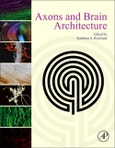Several excellent monographs exist which deal with axons. These, however, focus either on the cellular and molecular biology of axons proper or on network organization of connections, the latter with only an incidental or abstract reference to axons per se. Still relatively neglected, however, is the middle ground of terminations and trajectories of single axons in the mammalian central nervous system. This middle level of connectivity, between networks on the one hand and local, in vitro investigations on the other, is to some extent represented by retrograde tracer studies and labeled neurons, but there have so far been many fewer of the complementary anterograde studies, with total visualization of the axonal arborization.
The present volume brings together in one source an interrelated treatment of single axons from the perspective of microcircuitry and as substrates of larger scale organization (tractography). Especially for the former area - axons in microcircuitry - an abundance of published data exists, but these are typically in specialty journals that are not often accessed by the broader community. By highlighting and unifying the span from microcircuitry to tractography, the proposed volume serves as a convenient reference source and in addition inspires further interactions between what currently tend to be separate communities. The volume also redresses the imbalance between in vitro/local connectivity and long-distance connections.
Focusing on mammalian systems, Part 1 of this book is devoted to anatomical investigations of connections at the single axon level, drawing on modern techniques and classical methods from the 1990s. A particular emphasis is on broad coverage of cortical and subcortical connections from different species, so that common patterns of divergence, convergence, and collateralization can be easily appreciated. Part 2 addresses mechanisms of axon guidance, as these seem particularly relevant to pathways and branching patterns. Part 3 covers axon dynamics and functional aspects; and Part 4 focuses on tractography, notably including comparisons between histological substrates and imaging.
Please Note: This is an On Demand product, delivery may take up to 11 working days after payment has been received.
Table of Contents
Microcircuitry 1. Axonal projection of olfactory bulb tufted and mitral cells to olfactory cortex 2. The Primate Basal Ganglia Connectome as Revealed by Single-Axon Tracing 3. Comparative analysis of the axonal collateralization patterns of basal ganglia output nuclei in the rat 4. Anatomy and Development of Multi-specific Thalamocortical Axons: Implications for cortical dynamics and evolution 5. Geometrical structure of single axons of visual corticocortical connections in the mouse 6. Inter-Areal Connections of the Macaque Cortex: How neocortex talks to itself 7. Functional topography of cortico-cortical connections 8. Do lateral intrinsic and callosal axons have comparable actions in early visual areas? 9. Neuronal Cell Types in the Neocortex 10. Anterograde viral tracer methods
Axon dynamics 11. In vivo visualization of single axons and synaptic remodeling in normal and pathological conditions 12. Contribution of axons to short-term dynamics of neuronal communication
Axon guidance 13. Organization of Axons in Their Tracts 14. Cortical architecture, midline guidance, and tractography of 3-D white matter tracts
Tractography 15. The diameters of cortical axons and their relevance to neural computing 16. Critical Review and comparison of axonal structures in MRI/DTI and histology 17. Neuroanatomical techniques for analysis of axonal trajectories in the cerebral cortex of the rhesus monkey 18. High-resolution fiber and fiber tract imaging using polarized light imaging in the human, monkey, rat and mouse brain








